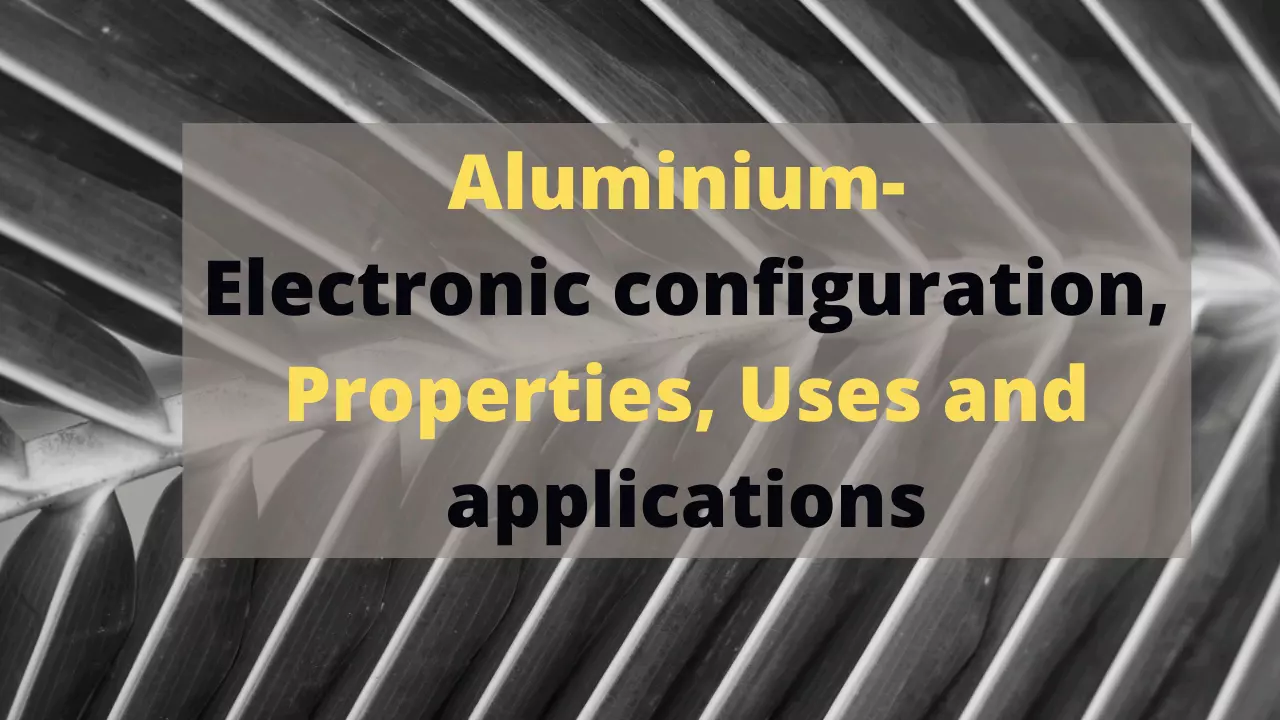
What is Aluminium? Electronic configuration, Properties, Uses
In this article we have explained what is aluminium and its symbol, electronic configuration of Aluminium, use and properties, so let's start with-
What is Aluminium?
Aluminium is a metallic element that is located in group 13 of the periodic table, in between magnesium and silicon. Its atomic number is 13, it has an atomic mass equal to 26.91 u, and it is symbolically represented as Al i.e. the symbol of Aluminium is Al.
Aluminium is a chemical element classified in the periodic table . It belongs to the family of poor metals, because the properties of these metals are less pronounced than those of other families of metals.
Aluminium is one of the most common metals found on the earth's surface, this being the third most abundant in the earth's crust, where in fact, its different compounds make up almost 8% of the lithosphere.
Aluminium is a name derived from the English "alumina" from the Latin alumen meaning "bitter " because of the bitter taste of the alum stone.
A human body in adulthood contains an average of 30-50 mg of aluminium, which is found in various organs such as lungs, bones, liver, etc. These quantities change according to age and organs.
[ Know- what is Zirconium? ]
Main characteristics of aluminium
|
Symbol of aluminium |
Al |
|
Atomic number of aluminium |
13 |
|
Family |
Poor metals |
|
Group |
13 |
|
Period |
13 |
|
Bloc |
p |
|
Volumic mass |
2.6989 g / cm3 at 20 ° C |
|
Hardness |
1,5 |
|
Color |
Silver |
|
Aluminium Atomic mass |
27.0 g / mol |
|
Atomic radius |
About 125 pm |
|
Electronic configuration of aluminium |
[Ne] 3s2 3p1 |
|
Ordinary state |
solid |
|
Fusion point |
660,323 °C |
|
Boiling point of aluminium |
2519 °C |
Now you know about aluminium and its characteristics, read further to know the properties & electronic configuration of Aluminium.
Physical properties of Aluminium
- Aluminium is solid under normal pressures and temperatures.
- Its boiling point is 2519 ° C, while its melting point is 660 ° C.
- The aluminium has a density of 2698.4 kg / m3. Given its low density, it is a light metal.
- It is a metal that reflects electromagnetic radiation well.
- It is of a grayish-silver color, soft, ductile, with a metallic and odorless texture.
- It is an anti-ferromagnetic metal.
- It is a metal with excellent thermal and electrical conduction properties.
- Its lightness is equivalent to 1/3 of that of other metals, such as iron or copper.
Chemical properties of Aluminium
- Aluminium has excellent anticorrosive properties. It is a metal with a high resistance to corrosion.
- It is made up of 13 protons, 13 electrons, and 14 neutrons.
- Its most common oxidation state is +3.
- Aluminium dissolves in bases and acids.
- It is a reactive metal when in contact with sodium hydroxide and hydrochloric acid.
- This metal is very reactive, making it a good catalyst for certain chemical reactions. It is also known to increase the power of ammonium nitrate explosions.
- Aluminium is an inert metal, so it does not present any degree of toxicity to living beings.
- In a liquid medium, aluminium exists in the form of Al3+ ions , it oxidizes to form alumina, formula- Al2 O3 .
- When this metal is heated in its pure state, it reduces the oxygen levels of the metal oxides.
[ Know- Properties of Neon ]
Electronic configuration of Aluminium
The atomic number of aluminium is 13, this means that this element has 13 protons & 13 electrons, in order to be electrically neutral. It also has 14 neutrons. We can write electronic configuration of Aluminium in two ways:
- Aluminium electron configuration in long form: 1s2 2s2 2p6 3s2 3p1
- electronic configuration of Aluminium in short form: [Ne] 3s2 3p1
The aluminium atom and Si+1 , P+2 , S+3 , Cl+4 have the same electronic configuration.
Aluminium has 13 electrons, we can fill the electron shells as per below:
- 2 electrons on the 1s-sublevel
- 2 electrons on the 2s-sublevel
- 6 electrons in the 2p sublevel
- 2 electrons in the 3s-sublevel
- 1 electron on the 3p-sublevel
[ Read- Selenium electron configuration ]
What is the oxidation state of aluminium?
The aluminium atoms in the compounds have oxidation states of 3, 1. The oxidation state of the Al3+ ion is 3 and the oxidation state of the Al+ ion is 1.
What is the electron valency of aluminium?
The valence of aluminium characterizes the ability of the Al atom to form chemical bonds. Aluminium atoms in compounds exhibit valence III, I.
What is the ionization energy of aluminium?
The energy spent on the separation of an electron from an atom is called the ionization energy and is denoted by Eo . The Ionization energy of Al: Eo = 578 kJ / mol.
Who discovered Aluminium?
Aluminium was discovered many years ago when the aborigines realized its benefits in dry cleaning and medicine as a double salt, better known as alum.
Although aluminium was a metal widely used by different ancient civilizations, its scientific discovery dates back to 1825 by the scientist Hans Christian Oersted . This Danish scientist was the first person capable of isolating the element in its pure state by means of electrolysis. So officially Hans Christian Oersted discovered the aluminium.
The extraction of aluminium from the rock, revealed several discoveries, such as that from it they could find small amounts of other compounds with the reduction of sodium.
During the nineteenth century, the production of aluminium was extremely expensive due to the elements that were needed for refining processes, it was known to be an exotic mineral.
In fact, its value was so precious that it exceeded the price of silver and the same gold of the time.
Over time, researchers found a number of ways to extract aluminium without the need for other high-value components.
[ Read- Who discovered Plutonium? ]
Isotopes of Aluminium
There are 22 known isotopes of aluminium, that means 22 different "versions" of aluminium with varying numbers of masses. The masses correspond to the neutrons added to the protons.There are isotopes from 21 to 42 Al. Only the 27 Al isotope is stable, thus aluminium is said to be a monoisotopic element .
Presence of Aluminium
Aluminium is an abundant metal on Earth, it is even the most abundant in the Earth's crust. It represents approximately 7.4% of the total weight of the earth's crust . In terms of chemical elements, it is the most abundant after oxygen and silicon.
Aluminium is a very reactive element that is why it is rarely found in nature in its pure. Because of this reason we find aluminium combined with other elements. The combination of aluminium with these elements is called "ore". In order to obtain pure aluminium, it is necessary to extract it from these ores.
The main ore where aluminium is found is bauxite.
Extraction of Aluminium
Initially Aluminium was considered a rare and precious metal . Because extraction of aluminium was very difficult.
Today, there are so many processes that allow its easy extraction, making aluminium an easy metal to obtain and therefore much less expensive than before.
The process commonly used from 1886 consists in extracting alumina in bauxite and then proceeding by electrolysis , which corresponds to a liquid medium. You should know that the extraction of a kilogram of aluminium requires approximately processing 4 to 5 kg of bauxite and a lot of energy.
How to obtain Aluminium?
Obtaining aluminium is generated through industrial procedures known as Bayer process and Hall-Heroult process, better known as the primary process.
Bayer process
The Bayer process is called the crushing of bauxite, when it is mixed with hot lime for a few hours.
This process is based on precipitation, where the coarse material (sand) is divided from the fine material (aluminium).
Wait a few hours until the mixture cools and a solid mineral precipitates, once the process is finished, it is washed with plenty of water.
Finally, it must be calcined at high temperatures to obtain the alumina.
Hall- Heroult Process
The Hall-Heroult process begins when the Al3+ cation is reduced and transformed into Al. This electric current process happens inside a reaction cell or electrolytic cell.
It must be taken into account that all ionic compounds in solid state cannot conduct electricity , nor can they move freely. But these conditions change once it is transformed into a liquid state, here it can function as an energy transport .
Uses and applications of aluminium
- Aluminium is commonly used in a large number of everyday objects such as kitchen utensils, electrical wiring, cans, but also in the aeronautical industry, among others.
- The biological properties of aluminium have earned its use in vaccines as an adjuvant (component to enhance the effect of the vaccine).
- Pure aluminium is malleable, but alloying with copper, manganese, magnesium or even silicon, this makes alloys with very varied properties allowing a wide variety of uses.
- Aluminium is also used in dialysis to balance the potassium level in dialysis patients.
- In addition, after iron, aluminium is the most widely used metal, mainly for its lightness and conductivity characteristics.
Know about more periodic elements- Gadolinium, Germanium Atomic Number, Neon, Oxygen, Potassium, Promethium, Selenium, Sodium Electron Configuraion, Terbium, Tellurium, Yttrium, Ytterbium Atomic Mass, Zirconium
Related Articales
Recently Posted
-
भगवान गौतम बुद्ध जीवन परिचय | Gautam Buddha in Hindi
December 15, 2022. -
कार्बन के अपररूप Allotropes of Carbon in Hindi
November 5, 2022. -
मिश्र धातु किसे कहते हैं? उपयोग, नाम, गुण Alloy in Hindi
July 27, 2022. -
गलनांक किसे कहते हैं? परिभाषा, उदाहरण Melting Point in Hindi
July 20, 2022. -
परिमाप किसे कहते हैं? Perimeter in Hindi
July 19, 2022.




